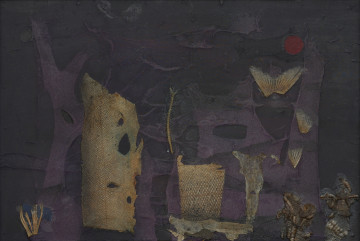
Cannibal Ship
1972
National Museum in Szczecin
Part of the collection: European classics of modernity
From 1930, Bogusław Szwacz studied at the Academy of Fine Arts in Kraków under Prof. Ignacy Pieńkowski, Władysław Jarocki, Karol Frycz, Jan Hopliński, Teodor Axentowicz and Xawery Dunikowski, among others. He was one of the co-founders of the local artistic community. Together with Tadeusz Kantor and Jerzy Nowosielski, he founded the Young Visual Artists Group, which later merged with the Krakow Group. From 1946, he was a lecturer at his alma mater. Between 1945 and 1948, he was a member of the Polish Workers' Party (PPR), and from 1948 of the Polish United Workers' Party (PZPR). In 1947, he went on a scholarship to France. After returning to Poland he lived in Warsaw. He was a lecturer at the State Higher School of Visual Arts, renamed the Academy of Fine Arts in 1950. In the 1960s, he was associated with the Krzywe Koło Gallery in Warsaw. After 1955, he began to create abstractions. At that time, he also developed the concept of Ars-Horme, or Sztuki Poruszania Wyobraźni [Art of Moving the Imagination], and realised its principles in his works. He presented them in the form of an artistic manifesto in 1977 during a plein-air workshop in Osieki. He called his compositions in the Ars-Horme style ars-hormegryphs and ars-hormegrams. In the collection of the National Museum in Szczecin there is work Klejnoty Bałtyku [Jewels of the Baltic] from 1969. It is one of a series of works with the same title, which were presented, among others, at the Festival of Polish Contemporary Painting in Szczecin. The painting Klejnoty Bałtyku, which is not in Szczecin's collection, depicts a collection of abstract forms against the sea. The canvas from the National Museum in Szczecin shows similar shapes against a black background. Following the concept developed by the artist, it is a combination of forms (signs, points and shapes on the borderline of objects and living organisms) referring to nature, but also to tradition and culture, which are to appeal to the viewer's imagination. The Baltic coast inspire them, and they aim to convey the emotional state associated with this space. They create dynamic relationships, play with colour and abstract deformation, which brings to mind associations with the cosmos, and sometimes, on the contrary, with the world seen under a microscope. By definition, they are ambiguous in interpretation.
Beata Małgorzata Wolska
Author / creator
Dimensions
cały obiekt: height: 112 cm, width: 195 cm
Object type
painting
Creation time / dating
Creation / finding place
Identification number
Location / status

1972
National Museum in Szczecin

1966
National Museum in Szczecin

1949
National Museum in Szczecin
DISCOVER this TOPIC
National Museum in Lublin
DISCOVER this PATH
Educational path